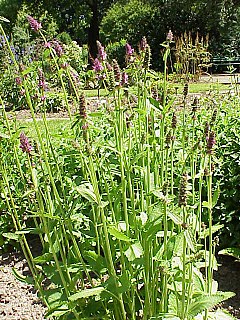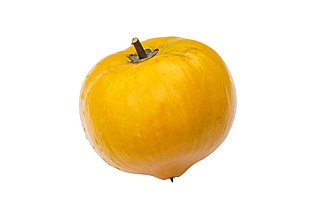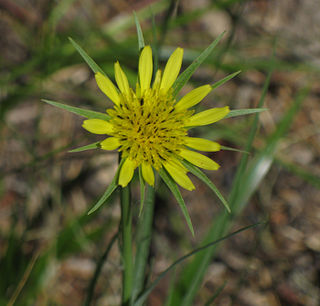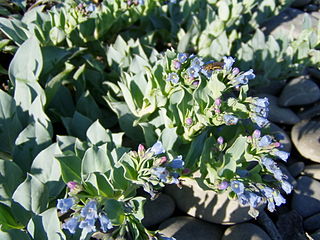
Tradescantia is a genus of 75 species of herbaceous perennial wildflowers in the family Commelinaceae, native to the New World from southern Canada to northern Argentina, including the West Indies. Members of the genus are known by the common names Spiderwort or Indian Paint. They were introduced into Europe as ornamental plants in the 17th century and are now grown as such in many parts of the world. Subsequently, some species have become naturalized in various regions of Europe, Asia, Africa, and Australia, as well as on some oceanic islands.

Tragopogon, also known as goatsbeard or salsify, is a genus of flowering plants in the sunflower family. It includes the vegetable known as salsify, as well as a number of common wild flowers.

Pachyrhizus is a small genus of five or six species of tropical and subtropical plants growing from large, often edible taproots.

Daucus carota, whose common names include wild carrot, bird's nest, bishop's lace, and Queen Anne's lace, is a white, flowering plant in the family Apiaceae, native to temperate regions of Europe and southwest Asia, and naturalized to North America and Australia.

The parsnip is a root vegetable closely related to carrot and parsley; all belong to the family Apiaceae. It is a biennial plant usually grown as an annual. Its long, tuberous root has cream-colored skin and flesh, and, left in the ground to mature, it becomes sweeter in flavor after winter frosts. In its first growing season, the plant has a rosette of pinnate, mid-green leaves. If unharvested, in its second growing season it produces a flowering stem topped by an umbel of small yellow flowers, later producing pale brown, flat, winged seeds. By this time, the stem has become woody and the tuberous root inedible.

Tragopogon porrifolius is a plant cultivated for its ornamental flower, edible root, and herbal properties. It also grows wild in many places and is one of the most widely known species of the salsify genus, Tragopogon. It is commonly known as purple or common salsify, oyster plant, vegetable oyster, Jerusalem star, goatsbeard or simply salsify.

Scolymus hispanicus, the common golden thistle or Spanish oyster thistle, is a flowering plant in the genus Scolymus in the family Asteraceae, native to southern and western Europe, north to northwestern France.

Stachys affinis, commonly called crosne, chinese artichoke, japanese artichoke, knotroot, or artichoke betony, is a perennial herbaceous plant of the family Lamiaceae, originating from China. Its rhizome is a root vegetable that can be eaten raw, pickled, dried or cooked.

Pouteria campechiana is an evergreen tree native to, and cultivated in, southern Mexico, Belize, Guatemala and El Salvador. It is cultivated in other countries, such as Costa Rica, Brazil, the United States, Taiwan, Dominican Republic, Australia, Cambodia Vietnam, Indonesia, India, Sri Lanka, Nigeria and the Philippines. The edible part of the tree is its fruit, which is colloquially known as an egg fruit.

Canna indica, commonly known as Indian shot, African arrowroot, edible canna, purple arrowroot, Sierra Leone arrowroot, is a plant species in the family Cannaceae. It is native to much of South America, Central America, the West Indies, Mexico, and the southeastern United States. It is also naturalized in much of Europe, sub-Saharan Africa, Southeast Asia, and Oceania. Canna indica has been a minor food crop cultivated by indigenous peoples of the Americas for thousands of years.

Glebionis coronaria, formerly called Chrysanthemum coronarium, is a species of flowering plant in the daisy family. It is native to the Mediterranean region. It is cultivated and naturalized in East Asia and in scattered locations in North America.

Tragopogon dubius is a species of salsify native to southern and central Europe and western Asia and found as far north and west as northern France. Although it has been reported from Kashmir and India, recent evidence suggests that specimens from these areas may be a different species. Western salsify has been introduced into North America where it has become widespread, being reported from all the continental United States except for a few in the far south-east, and all provinces of Canada except Newfoundland and the northern territories.
Tradescantia mosaic virus (TZV) is a plant pathogenic virus in the genus Potyvirus and the virus family Potyviridae. Like other members of the Potyvirus genus, TZV is a monopartite strand of positive-sense, single-stranded RNA surrounded by a capsid made for a single viral encoded protein. The virus is a filamentous particle that measures about 754 nanometers in length. This virus is transmitted by two species of aphids, Myzus persicae and Rhapalosiphum padi and by mechanical inoculation.

Leontopodium discolor, known as Ezo-usuyuki-sō or Rebun-usuyuki-sō in Japan, is a species of Edelweiss native to alpine areas of Hokkaidō.

Tradescantia spathacea, the boatlily or Moses-in-the-cradle, is a herb in the Commelinaceae family first described in 1788. It is native to Belize, Guatemala, and southern Mexico but widely cultivated as an ornamental and naturalized in parts of Florida, Texas, Hawaii, and various oceanic islands.

Alseuosmia macrophylla, the toropapa or karapapa, is a plant species in the family Alseuosmiaceae. This is a small evergreen shrub which is endemic to New Zealand, along with two closely related species. An example occurrence of A. macrophylla is in the North Island habitat of the Hamilton Ecological District, where Blechnum discolor and Blechnum filiforme are understory elements with Nothofagus truncata and rimu overstory. This plant is known for the pleasant scent of its flowers, and its family name translates as "perfumed grove". The small red berries of toropapa are edible and sweet tasting. As a forest understory plant, toropapa will not tolerate full sunlight or frost, and needs its roots to stay moist and cool, however so long as these conditions are met it is reasonably hardy, and is sometimes cultivated as a garden plant.
Commelina mosaic virus (CoMV) is a plant pathogenic virus in the genus Potyvirus and the virus family Potyviridae. Like other members of the Potyvirus genus, CoMV is a monopartite strand of positive-sense, single-stranded RNA surrounded by a capsid made for a single viral encoded protein. The virus is a filamentous particle that measures about 707-808 nm in length. This virus is transmitted by two species of aphids, Myzus persicae and Aphis gossypii, and by mechanical inoculation.

















